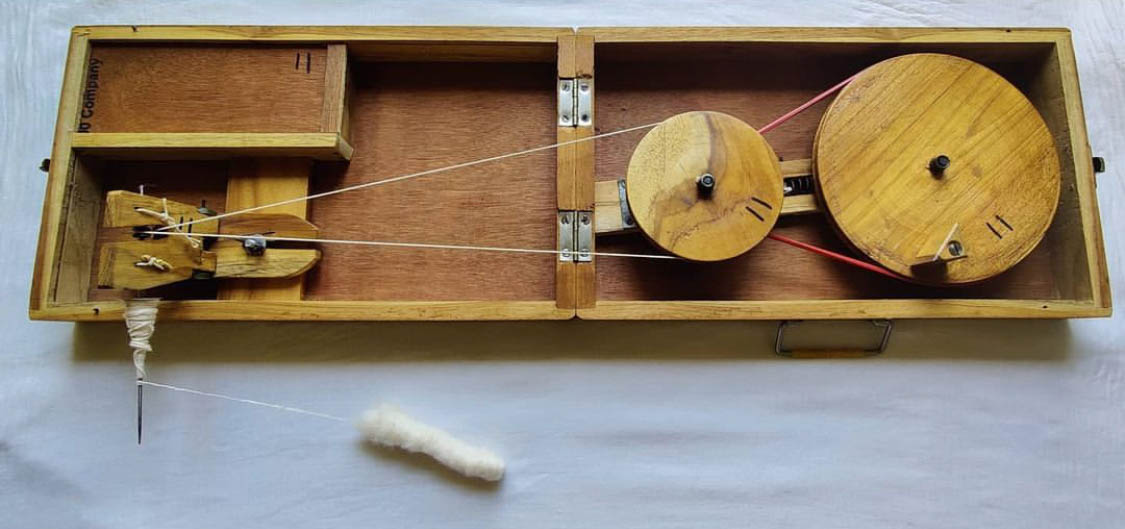
YuddhavirSingh Jadeja explains how spinning became part of his morning routine.
(A message to the reader.)
At the age of six, I had been exposed to textiles by my mother (Meeta Solanki Jadeja, founder of the house of amoda). Along with my twin sister and mother, our childhood weekend trips were in the fresh air of cotton fields, bathing in the indigo-dyed water, feeling the heat of hot boiling water, and being amazed at how the fabric washer is half dipped in the water tub for a long time, later carrying the wet fabrics in a cart dragged by one-two helpers, drying the long meters of fabric on the rope or on the land, patiently watching how sun rays and wind dried the wet fabric so quickly—at the same time listening to the rhythm of block printing and the beats of handloom weaving. I observed how the artisans were perfect and quick in their work. The atmosphere of rural places teaches us slow life, healthy life and an experience of “nature’s luxury” compared to urban life.
During my visits to the rural villages, I used to observe how the weaver men and women spin the charkha. I deeply observed their day-to-day practice and understanding of the art of spinning. Learning the techniques and meaning behind spinning made me curious to know more and more about it. I got the best advice from one of the weavers. Spinning charkha is not only about visual learning, however, but the best way is also to practice and understand the scientific purpose it grants the human body.
My learning to spin charkha had always been observational learning rather than formal teaching. Spinning charkha is a part of a traditional skill, hence its learning can never be taught but rather understood through experience. In beginning, the process of practising spinning charkha had been difficult for me due to having a very hyper nature. Hence the thread broke frequently. But after continuously practising for 3-4 months, I mastered a bit of the spinning technique.

For me, spinning charkha feels like meditating hence I practice it every morning and gradually it has now become a part of my life routine. Especially during the time of lockdown (covid19 pandemic), I spun to keep my mind calm, and balanced. Spinning charkha played an important role and made me feel relaxed.
From the age of 15, I started learning to spin, in the beginning, it was more fun and took it as a playful game. Later when I practised spinning every day which became a part of my morning routine. I observed why my threads broke; I realised the process of spinning charkha utilises a human’s left brain as well as right brain. While spinning charkha, the right hand is on the wheel which is continuously spinning and the left-hand holds poone (cotton ball).
The moment your mind is distracted the thread breaks which means the individual hasn’t balanced your right and left brain accurately. Hence the entire process is stopped and once again has to commence from the beginning.
Practising the art of spinning has developed a lot of focus and patience within me. It brings calmness and I now can evaluate my thoughts with a clear notion. Practising the spinning of charkha in my routine has made me understand a deeper purpose of it. It is a therapy of calmness within the human body. The spinning of charkha combines hand-eye-brain which is connected to the human soul. Hence one of our beliefs at amoda is “we CRAFT our Art from Heart”. Every process at amoda is done by hand by craftspeople.
amoda
At the age of 18, I joined my mother’s business as a creative director, developing amoda’s new collections and leading the overall creative vision of the company. I full believed in the motto: “Every fabric has a history, which takes you to a creative world of hand-crafted textiles-apparels of India”. Since childhood, I observed the process of textiles and learning from skilled artisans.
My vision while creating an apparel collection for amoda is to keep alive the fabrics (textile) of the past with contemporary design to achieve twenty-first-century market demand in the fashion industry. I believe that fabrics which are hand-crafted by weavers undergo the process of “warp & weft”. Handloom weaving helps the fabric to be “breathable” when worn by humans, as a result, it is comfortable, skin-friendly and timeless. At the same time through my design, the purpose is to safeguard the culture intertwined with the textile of India and create awareness for today’s generation. I want to keep alive the essence of traditional textile for the future generation.
amoda is a brand that brings together a rich knowledge of traditional textile and an innate passion for hand-crafted practices and understanding its sustainable process. The result is a brand that looks at lifestyle as a set of choices based on a commitment to people, practices and the planet. amoda’s three core pillars are: “traditional to textile”, “farm to fashion” and “culture to craft”.
About YuddhaavirSingh Jadeja
 I am 24 years old. I joined my family business when I was 17 years old and it was when I launched my first collection for the house of amoda. The collection was inspired by the ginkgo sea of yellow. I belong to Ahmedabad (Gujurat), located in the western part of India. My role at the house of amoda is Creative Director. My upcoming collection is inspired by the theme of the Great Ocean Road (Australia). The collection celebrates the skill of hand-painted textiles, the technique of resist batik, with four shades of colour palettes in each colour. Visit houseofamoda.com/our-story/
I am 24 years old. I joined my family business when I was 17 years old and it was when I launched my first collection for the house of amoda. The collection was inspired by the ginkgo sea of yellow. I belong to Ahmedabad (Gujurat), located in the western part of India. My role at the house of amoda is Creative Director. My upcoming collection is inspired by the theme of the Great Ocean Road (Australia). The collection celebrates the skill of hand-painted textiles, the technique of resist batik, with four shades of colour palettes in each colour. Visit houseofamoda.com/our-story/

